What Is the Meaning if You Drop Water Again and Again
In the back of the volume Scientific discipline Instruction in the Middle and Secondary Schools (2002), the authors Eugene Chiapetta and Thomas Koballa propose that "if yous identify a drop of water on a piece of wax paper and enquire the question, Does the drop of water scroll or slide across the newspaper? you will accept a puzzle that needs to be resolved and explained." The book then goes on to depict how the exploration might go along, explaining that some chalk dust or pepper in the drib volition help students see that the driblet rolls rather than slides. By mode of caption, the authors state that, "In this state of affairs, we observe the cohesive effects of h2o molecules permitting a drop of liquid to course and maintain a spherical shape that volition whorl on a surface without breaking apart." What does this really mean? Is this explanation plenty?
I decided to play effectually with this organization and see what things I could come upward with.
Let'southward get-go with the drop of water on the wax paper:

It is easy to see that the drib seems to have a "skin" property it into a sort of flattened sphere. It turns out that this surface tension is the result of the trend of water molecules to attract one another (called cohesion). The lowest energy land for this driblet occurs when the maximum number of water molecules are surrounded on all sides by other water molecules -- meaning that the drib should take the minimum possible surface expanse, which is a sphere. The issue of gravity flattens this ideal sphere into the shape we see.
Surface tension can be shown with many other demonstrations, including i in which you lot add together coins to a full drinking glass of water and notation how the surface rises well above the rim of the glass:
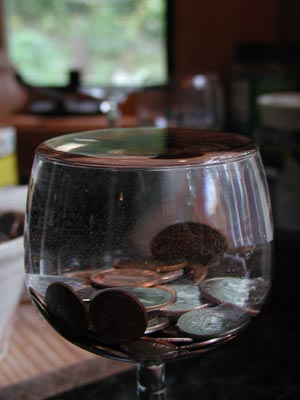
Though teachers oftentimes talk about surface tension being like a "pare", this is not actually an accurate model, as there is no other compound other than water in the glass. In addition, the surface does not react to being poked with a stick as a skin would. In fact, the water not but sticks to itself, information technology sticks to the wood as you can see past looking at the arrows in the moving picture. This is called adhesion considering the allure is to a different substance.
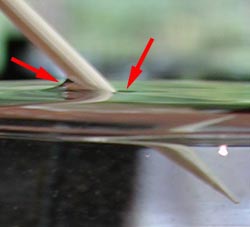
In all systems within which water interacts with another surface, both adhesion and cohesion are factors. When cohesion is more of a cistron, the water forms spherical droplets; when adhesion is more of a factor, nosotros get sheets of water.
The wax on the wax newspaper, information technology would seem, acts like the oil. You might accept read somewhere that wax and oil are hydrophobic and might remember that the wax and water are repelling one some other. Nonetheless, this is non quite truthful, as yous will see if you turn a piece of wax paper with droplet on information technology upside downwardly:
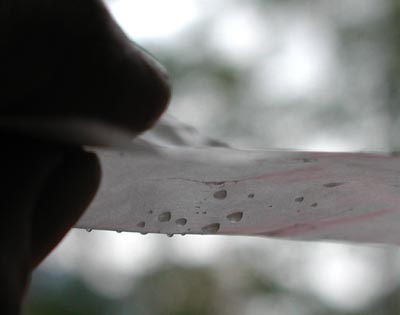
Since the water drops stay on the wax paper, there must be some sort of attraction betwixt these materials. It turns out the force of attraction between the water and the wax is actually quite strong, just it is less strong than the water-water (cohesive) forcefulness. For a good short discussion of a mutual misconception virtually hydrophobic materials, check out the Bad Chemistry folio at http://www.princeton.edu/~lehmann/BadChemistry.html#hydrophobic.
On clean glass, the forces of adhesion betwixt water and the surface are stronger than they are on oil or wax. The post-obit paradigm is of a mirror half of which I treated with butter (correct) and half of which I left alone (left). I then put the mirror in the freezer to cool it and harden the butter, removed it, and dropped some water on information technology. Detect that the water on the left side (where cohesion and adhesion were both major factors) formed a sheet. On the right, where cohesion won out over adhesion, the water formed drops:
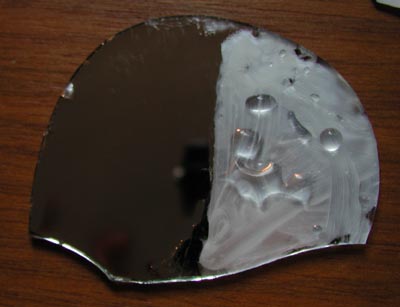
So now we accept a mental model of what is going on with a drop of water on a surface, and this should help usa think virtually the original problem. The water drop is close to spherical because of the cohesion of the water molecules. (Gravity squashes it, all the same.) This ball of water, of course, is as well somewhat attracted to the wax paper (adhesion); thus, when it is tilted, the surface of the h2o "sticks" to the wax, and the drop rolls. For more discussion of intermolecular forces, a proficient webpage is Intermolecular Bonding -- VAn Der Waals Forces, at
http://www.chemguide.co.uk/atoms/bonding/vdw.html
Now allow'south look at the glass again:
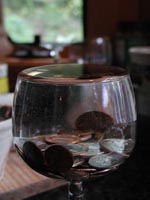
This principle is behind the trick of putting soap on your bathroom mirror to keep it from fogging. The fog on a mirror is acquired past many tiny drops of water condensing on the mirror and reflecting light in a variety of directions. The lather disrupts the cohesion of the h2o molecules, causing the water to form sheets (through which the epitome can exist seen relatively easily) rather than drops.
By the fashion, if we come back to our original driblet of water on the wax paper, we tin break the surface tension by calculation soap, and nosotros'll see that the drop changes into a flat puddle. Notice the relatively flat contour:
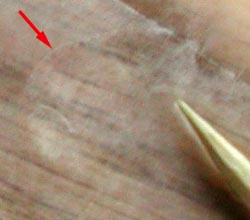
When we reduce the force of cohesion (past introducing soap), the drop changes shape every bit now the forces of adhesion and cohesion are more most the same.
One of the problems with an activity similar the original h2o drop experiment is that some students feel like there is one right reply and finish wondering about the phenomenon once this answer is found. Moreover, many people volition feel that finding out that the drop rolls is what this is all about, when this is actually only the kickoff. (In fact, even the book does a poor job explaining why it rolls and leaves one with more questions than answers.) A practiced instructor, by looking at a phenomenon more advisedly herself before grade, volition have many questions and avenues of research for those students who get to a place where they need a claiming.
©2001 Jeff Goodman
Source: https://www.appstate.edu/~goodmanjm/rcoe/asuscienceed/background/waterdrops/waterdrops.html
0 Response to "What Is the Meaning if You Drop Water Again and Again"
Post a Comment